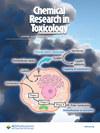透过迷雾看世界:COVID 后认知障碍的神经内分泌解释
IF 3.7
3区 医学
Q2 CHEMISTRY, MEDICINAL
引用次数: 0
摘要
促性腺激素释放激素与认知功能有关,而促性腺激素释放激素的丧失是大脑病理性老化的一个因素。这些过程与在长COVID患者身上观察到的神经和认知缺陷之间存在相似之处。在此,我们探讨了与长COVID相关的神经解剖学和转录组学改变可能源于这种神经内分泌干扰的假设。本文章由计算机程序翻译,如有差异,请以英文原文为准。
Seeing through the fog: a neuroendocrine explanation for post-COVID cognitive deficits
Gonadotropin-releasing hormone is implicated in cognitive functions, and its loss is a factor in pathological brain ageing. There are similarities between these processes and the neurological and cognitive deficits observed in patients with long COVID. Here, we explore the hypothesis that neuroanatomical and transcriptomic alterations associated with long COVID could stem from this neuroendocrine perturbation.
求助全文
通过发布文献求助,成功后即可免费获取论文全文。
去求助
来源期刊
CiteScore
7.90
自引率
7.30%
发文量
215
审稿时长
3.5 months
期刊介绍:
Chemical Research in Toxicology publishes Articles, Rapid Reports, Chemical Profiles, Reviews, Perspectives, Letters to the Editor, and ToxWatch on a wide range of topics in Toxicology that inform a chemical and molecular understanding and capacity to predict biological outcomes on the basis of structures and processes. The overarching goal of activities reported in the Journal are to provide knowledge and innovative approaches needed to promote intelligent solutions for human safety and ecosystem preservation. The journal emphasizes insight concerning mechanisms of toxicity over phenomenological observations. It upholds rigorous chemical, physical and mathematical standards for characterization and application of modern techniques.

 求助内容:
求助内容: 应助结果提醒方式:
应助结果提醒方式:


